Your opponents are using blog posts, videos, and other material to attract prospective customers toward their offerings or solutions. Analyzing and grasping how they do it can help you evaluate your existing content marketing methodology.
This will keep you updated in ever-changing times. You can also find novel methods and make your audience notice your work by utilizing the power of content.
Here is a stepwise plan to review and analyze your competitor’s content marketing. Using this plan will help uncover your content strategy’s strong attributes and also weaknesses.
Disclaimer: If you buy any products through links on this site, I may earn a commission. But it doesn't make any difference to your cost, and it helps me keep this blog running. So you could always read my articles for free.
What is a competitive content analysis?
A 2020 Crayon report shows that a typical company has 29 competitors. A competitive content analysis is an audit of your rival’s content that follows a defined procedure. This procedure has organized steps to review your competitors’ content approach.
Following a step-wise approach helps in two ways. Firstly, it reveals your competition’s top–notch and effective content. Secondly, it reveals their shaky areas which can be leveraged to your benefit.
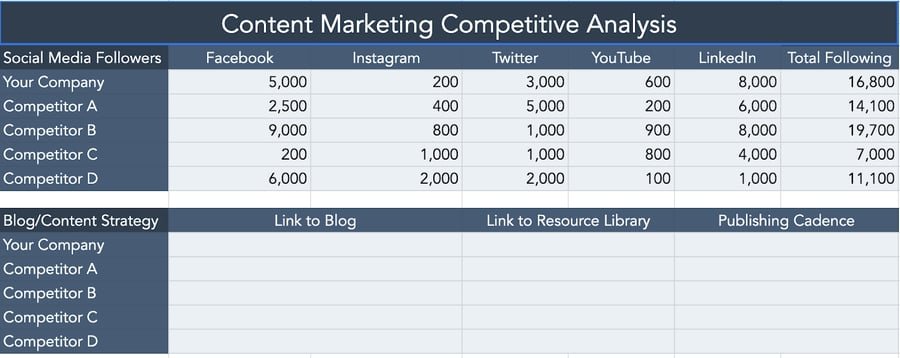
Image Source: Hubspot
Why do a competitive content analysis?
According to 90% of companies, the competition in their market has increased in the last three years. So competitive intelligence is crucial to their success.

Image Source: Crayon
Studying your competitors’ content marketing can help you in numerous ways:
Establish success metrics: Competitive analysis helps you understand how effective your content marketing campaigns are compared to industry benchmarks. It also reveals what resonates most with your target audience.
Find holes in your content strategy: By studying your competitors, you can discover top-performing topics to create new content. Plus, you can learn to avoid creating content that doesn’t get any traction.
Stay relevant: Competitors can inspire you to try out new ideas to boost your content marketing efforts, helping you stand out in the market.
Overall, thorough competitive content analysis allows you to get ahead, or at least stay in the same league as your biggest competitors. Otherwise, you risk losing market share, and it may take a long time to earn back the trust of your target audience.
Steps to analyze competitor content
Conducting a competitive content analysis takes some effort. But overall, it’s an easy process.
Identify your competitors
To begin analyzing your competitors’ content marketing assets, create a listing of your primary and secondary opponents as a first step.
Your primary opponents are any brands, enterprises, or individuals providing offerings or solutions identical to you.
Your secondary opponents are any brand name, enterprise, or individual providing offerings or solutions that vary from yours. Except, they could meet identical buyer requirements. Beyond that, they may address issues identical to your offerings or solutions.
To begin collating your blueprint to determine your opponents, you need to do some groundwork. Here are the two key inquiries.
Does competitor X have identical competencies? Competitors with identical competencies are commonly strong rivals. They typically have a key strategy that is common with you, such as their tech infrastructure, marketing plan, how they attract talent, or expertise.
Does competitor X have the same target audience and requirements? Next is the no-brainer step to find who and what those are.
Below, I’ll examine how analyzing buyer needs can aid you in this matter. A great way to do this is to observe customer behavior in the market. This includes customer reviews, buying patterns, and loyalty to vendors.
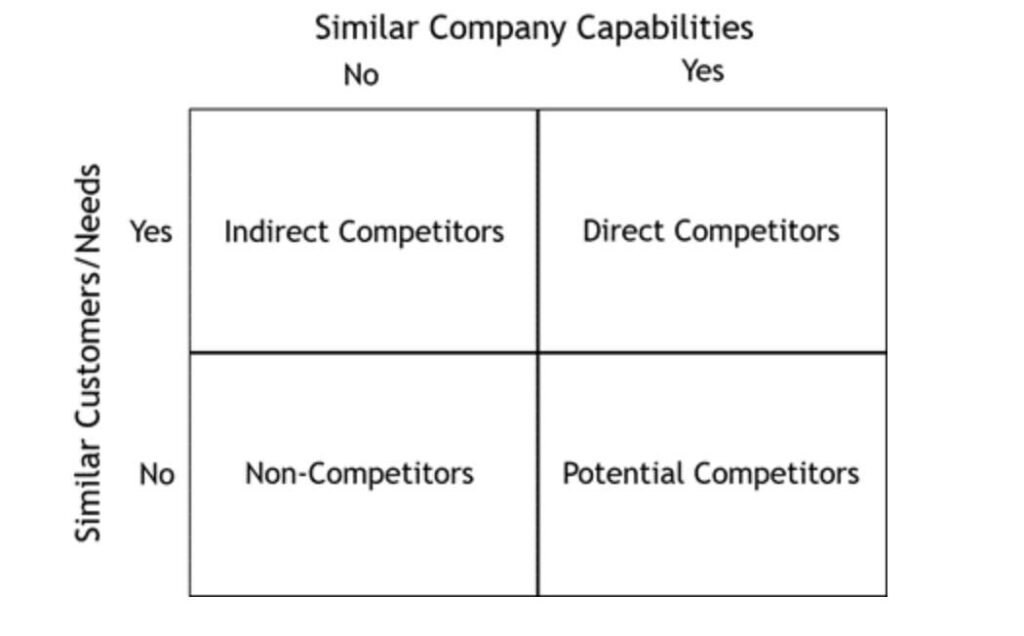
Image Source: Divbyzero
To sum up, you need to compile a listing of your primary and secondary opponents. They would each have a different approach to their content marketing. So you can study their individual strategies.
Analyze your competitors’ core proposition
Begin with your primary and then secondary opponents. You need to collect their background and general info. This is to get a grip on their content marketing objectives and market segments.
Take a quick peek at their main page’s headline and meta description. You can see this in the SERPs. Or you can take the help of SEOquake to extract it from their website.
And don’t forget to examine their main page content. How do they describe themselves and their work?
Another way is to skim through your opponent’s site to visit the offerings and solutions sections. These sections commonly affect content marketing efforts and determine content types. So, it’s crucial to invest time in understanding precisely what every opponent has to offer.
When doing so, you can also understand whether your opponent is successful or emerging in your field. Is your opponent already a widely known brand name? This will aid you in evaluating your advantages and constraints in an unbiased manner.
Here is a sample framework. You can utilize it to examine your opponent’s core position in the market and his content marketing assets.
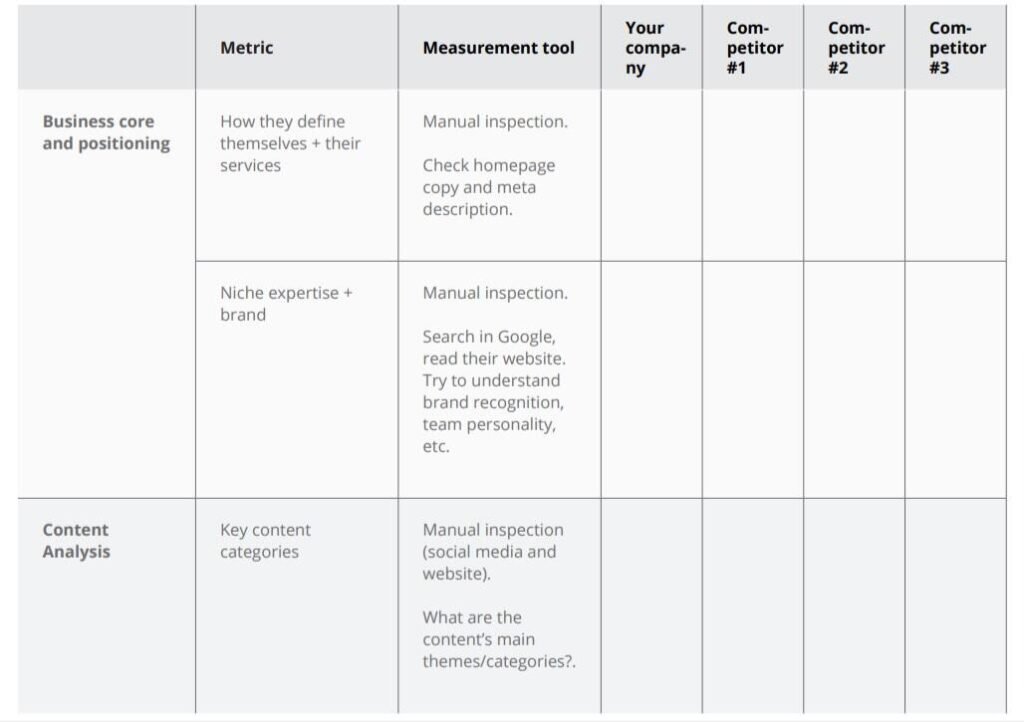
Image Source: PaperStreet
You can collect these details by searching Google about each opponent and reading through the results. Then, you can check the “About Us” section on their website. Plus, you can search Crunchbase to see if they are considerably funded and gather more info.
Make an inventory of their marketing collateral
Now, you are ready to explore in detail the materials your opponents are developing on their sites. Doing this will help you in two ways. Firstly, it will help you discover trending content marketing strategies in your field. Secondly, it will spark in your mind with novel ways to upgrade your content marketing approach.
Make a list of every type of material and every website that has published it. That is, analyze all content types from their site and whatever they have posted elsewhere, from written content to video clips.
Every type of content asset reveals the following:
- The degree of content marketing allocation
- The kind of content their users like
- The scope and the comparative value of subjects and keywords
Different kinds of content pieces you can note are:
Blogs: Regularly posted blogs are brief write-ups that provide a view into the variety and related significance of the subjects and keywords discussed.
Audio streaming and recorded podcasts: Audio clips can add variety to how the staff functions and how they view specific subjects.
Live webcasts: Archived and planned web events usually provide detailed insights into a specific subject as per user demands.
White papers and ebooks: From awareness stage materials to in-depth informational guides or study reports, detailed write-ups focus on crucial desired subjects.
Visual media: Video-based content assets can provide you with a more exhaustive view of the opponent’s branding and style.
Slideshows: Whether SlideShare content or other forms, slide-based demonstrations are full of subject matter expertise and promotional material.
Email series: Email messages show what type of material your competitors feel adds the most value to their existing and prospective users.
To find out how many web pages are on your website and any other opponent’s website, run the “site” operator when using Google. Simply look for “site:http://webaddress.com” and it will display all webpages on that domain address.

Label and assess content pieces
After you have taken stock of your opponents’ articles, blog posts, and other material, the next step is to assess them.
It is crucial to analyze your opponents’ emphasis on every content format and how the target market receives it. As you analyze their content assets, observe how they classify their main content.
Studying your opponents’ content themes is a good method for discovering your niche’s highly trending content categories. A great trick for locating this detail is to look at the key content categories and labels on your opponents’ websites.
Going ahead in this study, now you need to see the minute details in every type of content separately. Labeling and assessing the subject of every content asset reveals voids in content marketing. You can then fill them up and use them to your advantage.
According to a study by CMI, MarketingProfs, and ON24, 83% of marketing professionals say they try to stand out in the market by producing better-quality material, and 72% said they create content on subjects that competitors leave out.
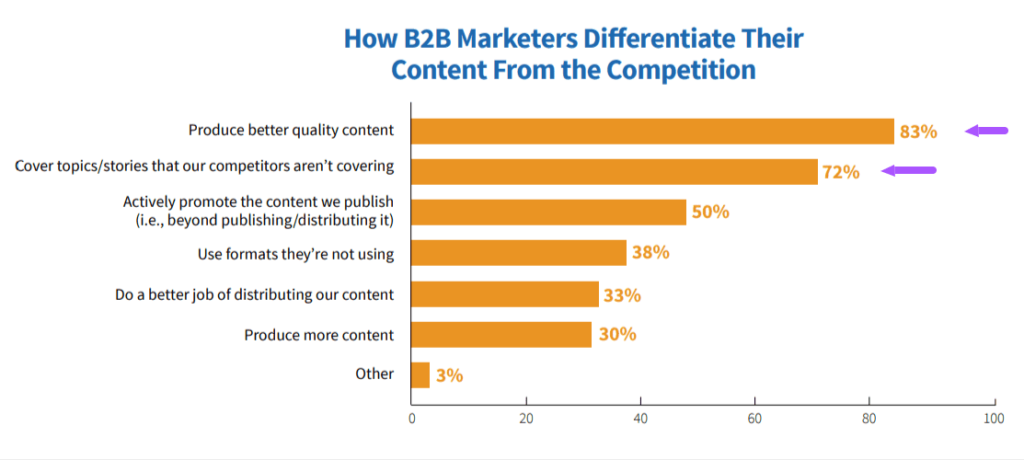
Image Source: Content Marketing Institute
As you analyze every content asset, notice the piece’s heading and meta tags, and go through as much of the material as possible.
If an opponent has a lot of material to scan through, begin with the highly trending content and mediums, or the latest posted material.
Content marketing is a creative endeavor. So you can’t measure everything objectively. But there are some standard parameters that you can consider to determine the level of their content’s performance.
For instance:
- Do they have a common layout?
- Do you find any language errors or misspelled words?
- Is the writing of content clear and straightforward?
- How comprehensive is their content?
- Do they include high-resolution visuals or styling?
Try to grade each of these parameters on a scale of 0 to 10 according to your judgment and your assessment of their assets’ potential.
Analyzing both the volume and usefulness of their collateral as categorized by subjects will point out those subjects that you need to avoid and those that your competitor has left out. Then you can cover this void.
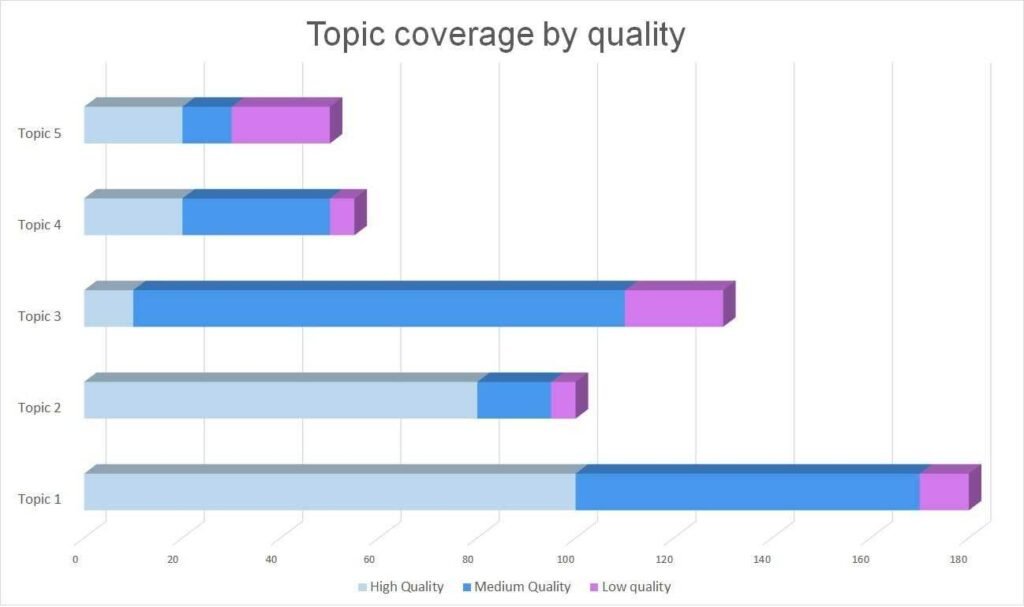
Take every content item, and label it to put under a subject or in a group of subjects. As a final result, you will have decoded your opponent’s content marketing plan into a comprehensive worksheet.
Check how often they upload content. Take inventory of the kinds of multimedia and avenues they use. Also, check how often they are uploading that kind of content on that type of medium.
Making an index of the main content types your opponents are utilizing will indicate to you how many hours and how much manpower they are allocating for content marketing.
You can also check how frequently they develop various kinds of material. With this insight, you can find strategies to copy or to take inspiration from and build your own.
Analyze trends/patterns
The fun begins now. Arrange the quality and quantity numbers you have so far in line with your content inventory. The result would be a high-level laydown of your competitors’ content marketing.
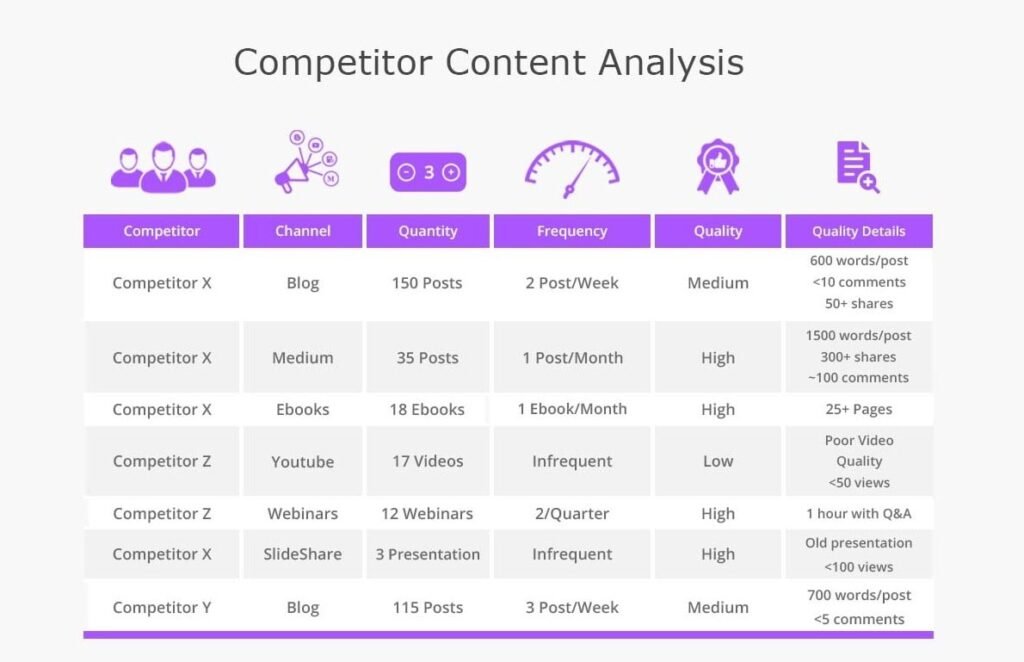
When you examine the quantity and quality of how much content your competitors have produced on different topics, you will get a sense of what you can do better.
You’ll get to know the topics you should avoid and the holes in their content arsenal that you can fill. And in doing so, you’ll get a plan to stand out and succeed.
Examine key metrics
Another aspect of a great competitor content analysis is to pay attention to your competitors’ performance metrics.
This way, you can zero down on what type of content you’re not producing at the moment that’s likely to do well.
To demonstrate, let’s say you find that a good number of visitors are showing a lot of interest in your competitor’s video content. So you might be better off creating more video clips too.
And you’d also get to know what level of performance you can expect from this content. Here’s what to consider:
Content engagement – Analyze patterns related to the level of engagement. Looking at the number of likes, comments, and shares will help you make sense of the way content is performing.
Organic search traffic per month – When you have the organic search traffic metrics of your competitors, you can compare and benchmark the same for your own content.
You also shouldn’t overlook the time visitors spend consuming and engaging with your content. The more, the better.
So how would you do this? The answer is an SEO analytics platform. You can pick from many, such as Ahrefs, SimilarWeb, and Semrush.
If you’re using SimilarWeb, for example, all you need to do is enter your competitor’s website address, and you get their traffic data.
Domain Authority – Domain authority helps you test the high-level success of your competitors’ content marketing activities. As before, compare with your own strategy to see where you can improve and how.
Keywords associated with top-ranking content – Take a look at the keywords for which your competitors are ranking really well. How many are there? This will allow you to learn who among your competitors is implementing the best content marketing plan.
Take a page from their book and experiment with fresh content topics. Again, an SEO tool can help get this data.
For example, go to the Mangools’ KWFinder and enter the website URL of one of your competitors in the “Search By Domain” section. And you’ll get the keywords where your competitor has top ranking.
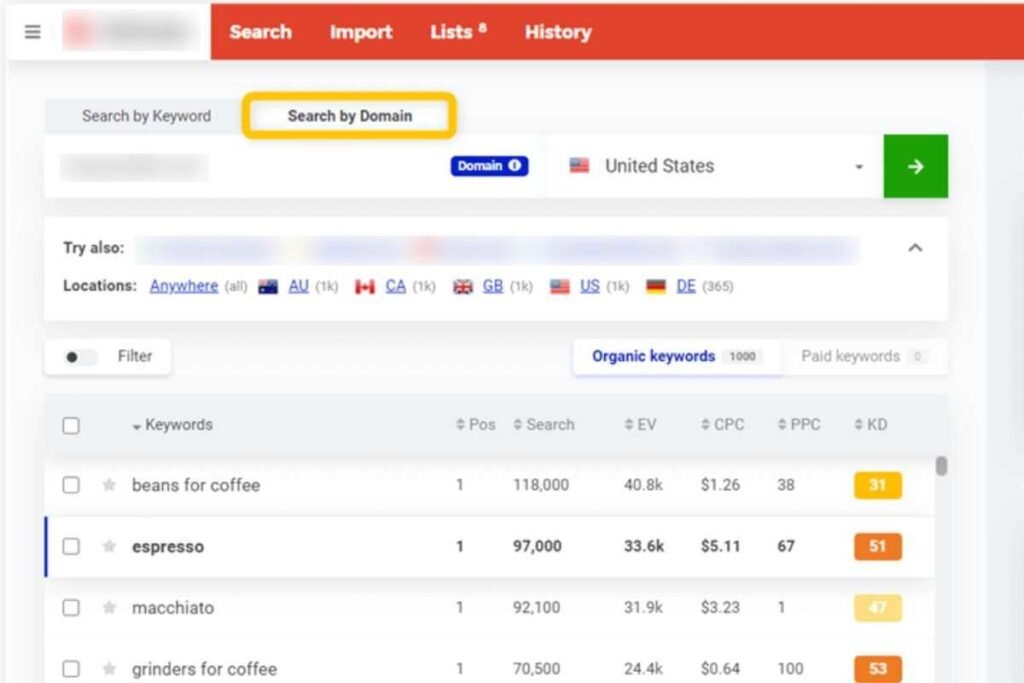
Image Source: Mangools
Backlink analysis – Are your competitors acquiring many backlinks? From where? This data lets you identify link-building opportunities for your own content. For this data too, you’ll require an SEO tool, as previously discussed.
While analyzing all the SEO data I have covered so far, make an effort to zero in on the strengths and weaknesses of your competitors. The following questions will help you get started:
- Is getting organic search traffic hard for some of your competitors?
- What types of content are getting the most and the least engagement?
This way, you’d able to figure out your brand’s standing among competitors. And then set realistic performance goals for your particular industry.
Analyze content promotion/conversion tactics
Many companies develop a great deal of content. Having said that, they overlook two key things. First, they don’t make an effort to spread it. Second, there is no call to action for their target audience to take action and turn into a prospect.
So it’d be great if you could identify your competitors’ content promotion techniques and what they do to get buyer details from their online presence.
Calls to action – When analyzing competitors’ content marketing, examine factors such as email capture forms, pop-up displays, and lead magnets. Also, see if there are additional techniques at work.
As you do this, you’ll begin finding commonalities in terms of the kinds of resources and calls-to-action they put forth. It’s a great signal of what’s likely to perform better considering your industry.

Influencers and thought leaders – These days, it’s common for brands to collaborate with thought leaders and related businesses. The result of this collaboration is content that captures the interest of their readers.
Find out the names of thought leaders working with your competitors to develop content. And you’ll have the data of potential partners that you can also contact.
Check content team
As per a 2021 study, 42% of marketers mentioned that the content marketing staff in their organization has only one to three team members. Only 3% of organizations possess a content marketing team of over 50 people.
In contrast, 21% of companies had no professional assigned specifically for content marketing.
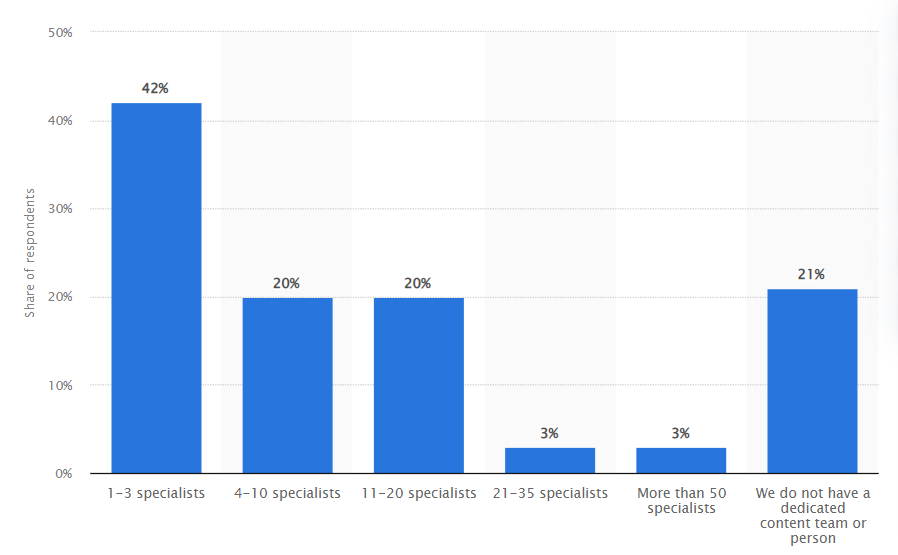
Image Source: Statista
Before you start hiring for your content marketing staff, look at the About pages or the LinkedIn business pages of your competitors. Why? Because this way, you’ll get a clear sense of how many content marketers they employ and the tasks they do.
Check out the designation of every person in their content marketing staff. This will give you an idea regarding the type of people they are investing the most in.
For example, do they have a lot of manpower devoted to social media marketing? Or are they putting more resources into video marketing?
Head over to LinkedIn and open your competitor’s business page. Then go to the “People” tab. Now, type in terms like “content” and “marketing” in the given search box.
Act on the insights you gathered
You’ve now collected a lot of data about your competitors. So now it’s time to take action. Depending on your competitors’ strengths and weaknesses, summarize all you can do to improve your content marketing. For example:
- Choose the competitors you should keep tabs on with regard to content marketing
- Come up with fresh content topics and types
- Apply new strategies to convert readers into leads
- Zero in on your weaknesses
- Experiment with new methods to optimize your content strategy
Common questions about competitor content marketing
Here are some frequently asked questions about analyzing your competitors’ content marketing strategies, and their answers.
What is a competitive content marketing analysis?
A competitive content marketing analysis involves a detailed procedure of identifying and evaluating businesses similar to yours. This gives you valuable information to stand out in your industry.
How often do I need to do a competitive content analysis?
You should carry out a detailed assessment once a year, along with short evaluations after every few weeks. Take note of what your business needs depending on how much content you produce.
Why analyze your competitors’ content marketing?
A competitive content marketing analysis lets you focus on key factors, and the resources to measure them. Plus, you can check your target market’s engagement patterns and requirements.
The point is, examining your competitors’ content strategies gives you accurate data on the kind of content to produce. You will also understand the level of engagement to expect from your audience.
How do you create content that beats the competition?
To make content that stands out, a great method you can employ is the skyscraper technique. Identify content in your industry that has attracted a lot of backlinks and engagement. Then create an improved version of the same topic. Target relevant users to spread the word.
Summing up: competitor content marketing
If you want your content to beat the competition, you should make it a routine of finding and using information about your rivals’ content marketing plans.
Another benefit of a competitive content marketing analysis is that it gives you new ways to collaborate with related businesses. This way, you can target a market common to both and leverage the content production abilities of two entities instead of one.
Taking a thorough look at the content marketing industry around you may be tedious.
Nevertheless, it’s an important activity. It lets you make distinct content that really catches and holds your audiences’ attention. Rather than shooting in the dark, make sure to seek out tangible ways to produce useful assets.





